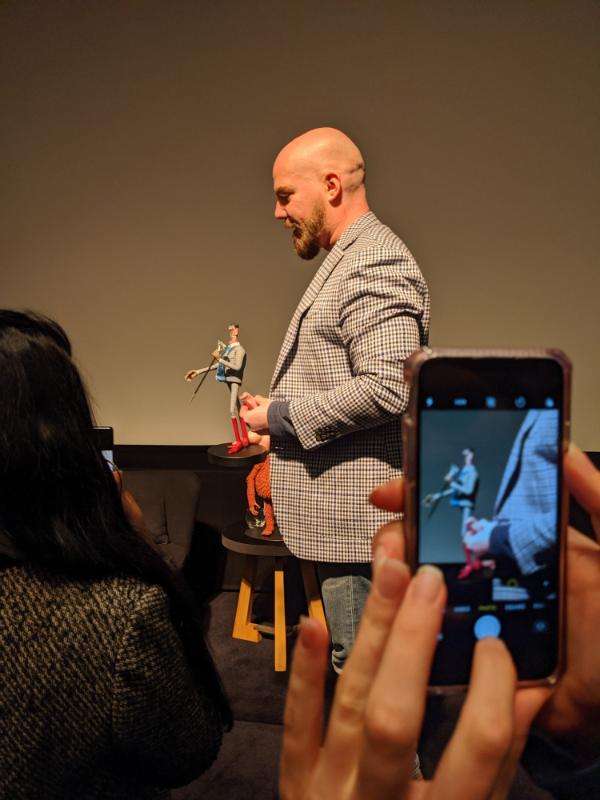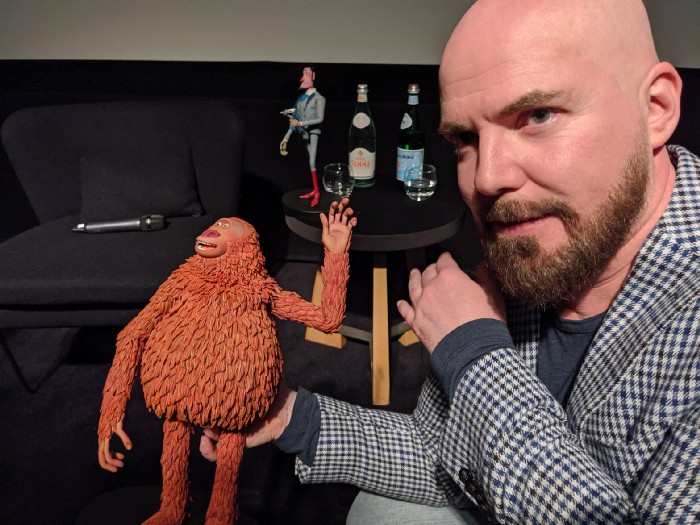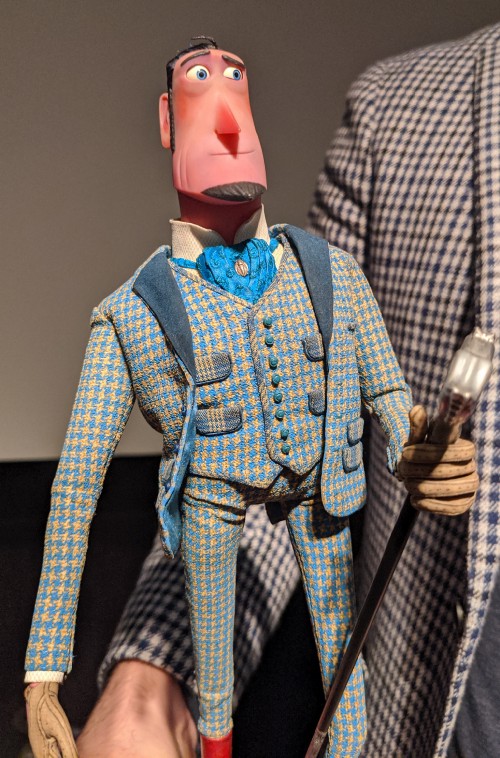Animation students link up with UCA Golden Globe winner Chris Butler
He’s a UCA graduate with a Golden Globe-winning and Oscar nominated movie to promote, but Chris Butler got back to his roots last week when he took time out from his schedule to meet our current crop of animation students.
05 Feb 2020
/prod01/channel_8/media/uca-2020/news/blog/Chris-Butler,-centre-back,-with-BA-(Hons)-Animation-students-in-London-last-week.jpeg)
Chris, who is now based in LA where he works at Laika Studios, was on a whistle-stop tour of the UK and invited more than 40 BA (Hons) Animation students to the Mayfair Hotel in London for a screening of Missing Link, followed by a fascinating Q&A.
The movie won Best Animation at this year’s Golden Globes and was shortlisted for an Oscar — losing out in the end to Toy Story 4.
“After the screening, he spent an incredibly long, and generous, amount of time allowing our students to ask creative, technical questions about the puppets and the film. He let everyone hold the puppets and take photos and he said he would love to come back and see us all,” said Animation Programme Director Lesley Adams. “He apparently used to work at The Plough in Farnham, so we’ve offered him free beer when he returns! He was lovely.”
Patrick O’Mahony, one of our stop-motion technicians, also attended the talk.
“After I asked him about the difficulties he faced while making Missing Link, to help reassure our students and to help us understand the work and effort that goes into a production such as this, Chris spoke of the finer details of dealing with hardships breaking down key moments where he questioned why he had done this to himself, being the writer, but proving that you get out of a project that which you put in,” said Patrick.

“It was this honesty and enthusiasm that hopefully shone a brighter light on those darker moments the students face and will face when trying to create their own work now and after the course.
“The highlight was the extra time spent with Chris after the Q&A. He wholeheartedly gave his time to speak to us and the students one on one while also giving us the rare chance to hold, photograph and play with the two main character puppets; Mr Link and Sir Lionel Frost.
“His dedication to making sure each student was heard and the depths of his answers was amazing experience and the end to a great one-off evening that truly cemented him as a Farnham Animation family member.”
In an initial chat with host James King captured and kindly shared by one of our students Daniel Aguirre Hansell, Chris talked with the audience at length about the night he won the Golden Globe for the movie.
“I don’t remember any of it!” he exclaimed. “We really did not think we had a chance of winning there. We were up against big movies, not just the biggest animated movies of the year — the biggest movies of the year, the biggest movies ever, really, when it comes down to it. In fact, even when we got to the table, we were on the second tier, and I looked around and said to my producer, ‘if we win how do we get to the stage?’, and she looked at me and said ‘Chris, we’re not winning!’. And so when they said it, I just don’t remember! I had no speech prepared, we were genuinely shell-shocked, but it was such a great feeling. I was clutching that six pound golden trophy in my hand for about 24 hours, I would not put it down. It was good.”
Chris went on to talk about his background, and revealed he wanted to be an animator at a very young age.
“I think I told my mum when I was three when I said wanted to work in animation,” he said. “I think it was The Rescuers, by Disney. Also 101 Dalmatians. I can’t tell you why, but it resonated with me and I knew from that age I wanted to do this.”
After graduating from UCA in 1996, Chris went on to work for Disney, working as a designer on The Tigger Movie, and as a storyboard artist on Tarzan 2.
He said: “It was not the best time for animation back then, there wasn’t a lot happening. So, I moved to London and worked on a lot of commercials and TV shows and did end up doing pre-production for the straight to video Disney sequels that happened around that time. Then things started to change. I heard Tim Burton was making a stop-motion movie in London, Corpse Bride, and I wanted to be on it, and that kind of clarified for me that I wanted to work in stop motion. I really enjoyed that experience.”
Chris talked at length about how Laika operates as an animation studio, and the ways they — through Missing Link — have pushed the boundaries of stop-motion cinema.
“What we’re trying to do is embrace technology. We love this medium, we love what is vital about it — real light on real objects — but we also want to take advantage of whatever we can to make it even better. You could say we make hybrid movies, we’re using a lot of technological advancements.
“If we didn’t do that I don’t think a movie of this size would be possible. Even ten years ago this movie wouldn’t have been made — the amount of locations, the amount of characters, would have been impossible.
“It was very ambitious, probably too ambitious, and there were definitely times in production when I was thinking ‘why did I do this? why did I write this?’ because it’s nobody else’s fault! But at no point did Laika say, ‘don’t write that’. They said, ‘we’ll figure out a way to do it’.”

Chris also talked in detail about the incredible puppets used in the movie, explaining to the audience how they were created and animated.
He talked about how costume designer Deborah Cook had to find miniature versions of fabrics, like houndstooth, so it looked realistic on screen, how a total of 107,000 faces were 3D printed and created for bespoke shots, and how there were no true blacks in any of the colouring.

He also revealed the character Mr Link — voiced in the film by Zack Galifianakis — was late to set by a year.
“We shot around him, shot a lot on green screen — for the bar-room brawl, we shot certain points a year before the rest of it. We always talk about the people who make and animate the puppets but I think there should be more kudos to the production team who had to juggle a lot.”
Chris spoke too about how animators and actors worked together to create the characterisation on screen — with actors providing the voice and often the animators themselves creating actions to mimic through what’s known as LAVs (live action video references).
“It’s more than the voice for sure,” he said. “We start to record them, we always have cameras in the room, we give all the footage goes through to the facial animation dept and they pore through it all. It’s a tricky thing because voice recording for animation is the purest form of acting, because it’s just the actor and the script. You can give them bits of artwork but there’s no set, there’s no props, there’s no finished puppets — it’s just them in a booth on their own.”
Chris, who said he was inspired for Missing Link’s style and characterisation by 101 Dalmatians and the Richard Williams animation The Thief and the Cobbler, added: “The animation itself [from those movies] is also very figurative and I think it comes back to what Disney calls “the illusion of life”. If you look at 101 Dalmatians, you’ll look at the badd’uns Jasper and Horace. Jasper has these huge crane-like legs, but he moves like a human being, he moves like a real person. And that’s what I was going for here.
“I think that’s the challenge that is so beautiful and rewarding in animation, is that you can have these incredibly stylised characters but you can animate them in a way that makes people believe they are flesh and blood.”